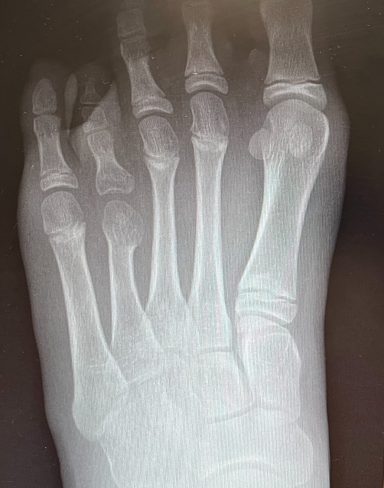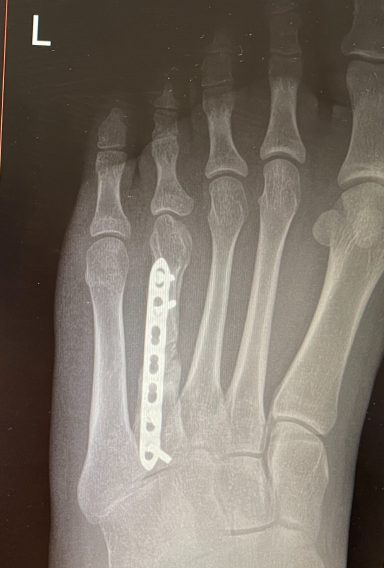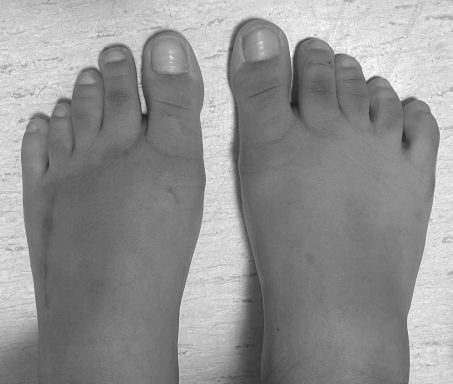Brachymetatarsia (Short Toe)
What is brachymetatarsia?
Brachymetatarsia is a short metatarsal affecting the feet. Usually it can affect one or more metatarsals. The most common metatarsal appears to be the fourth metatarsal and the patient presents with a short or elevated fourth toe. It appears to affect woman more than man.
What are the causes of brachymetatarsia?
The cause of brachymetatarsia is poorly understood. We do know that what tends to happen is that the metatarsal growth becomes stunted and there are theories around this possibly being related to injury but it is often also seen in family members and therefore could present a strong genetic link.
Can brachymetatarsia be fixed?
Brachymetatarsia can only be corrected via lengthening procedures of the metatarsal. This usually involves performing surgery using various techniques that are available.
What happens if brachymetatarsia goes untreated?
Patients often complain of the toe impinging against the shoes and causing irritation. Some patients have never worn opened-toe shoes and others have never been comfortable in front of their partners to expose their feet. The impact appears to be wide and varied.
What are the treatment options for brachymetatarsia?
Non operative management includes wearing roomy deep shoes if one does not elect to have surgery.
Surgical lengthening of the metatarsal is the mainstay of operative treatment.
In terms of surgery there are two mainstream treatment options. The first one being a single-stage lengthening procedure which involves cutting and lengthening the bone and using a bone graft either from a patient or bone bank or artificial bone to interposition between the graft to maintain the length. Screws and plate specially designed for lengthening are used to stabilise the lengthened bone and the bone graft until healing has been achieved.
The other common technique is external fixator. The fixator is placed on the bone and held with specialist wires. The bone is cut and slowly lengthened over a few weeks. The fixation is then held in place until the bone healing has been achieved on X-rays.
If treated by a single stage method the plate and screws stay in place and are not routinely removed. Other risks include, pain, bleeding infection, scar, nonunion, malunion, DVT, PE, need for further surgery
How do you fix brachymetatarsia without surgery?
It is not possible to fix brachymetatarsia or lengthen the bone without surgery.
How long does it take to recover from a toe lengthening (brachymetatarsia) surgery?
The length of recovery typically depends on the type of procedure.
The single stage lengthening procedure would involve you to be in a cast for six weeks postoperatively with no weight on the foot until some bony consolidation is seen where the bone graft is placed to lengthen the bone. Following that patients typically will be in a walking boot for another four weeks. At 10 weeks postoperatively they are allowed to return to trainers. However, the swelling will continue to subside typically for up to six months and can even take up to a one year. The toe becomes stiff after the surgery and will require some therapy to try to regain the range of motion.
The external fixation technique requires you to be in a cast for approximately six weeks. The first three weeks are typically where the lengthening is taken place by daily rotation of the dials on the external fixator. The fixator is then held in place for anything up to three to six months depending on bone healing. Most people can have the fixator removed at three months but may well still be partially weightbearing on the foot. Complete healing can take approximately one year.
When can I walk after brachymetatarsia surgery?
Walking after brachymetatarsia surgery in both cases will not be allowed for first six weeks. Following this one can place weight but may still be in a protected boot for a prolonged period.
We need your consent to load the translations
We use a third-party service to translate the website content that may collect data about your activity. Please review the details in the privacy policy and accept the service to view the translations.



